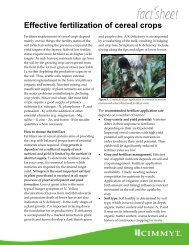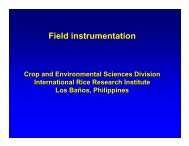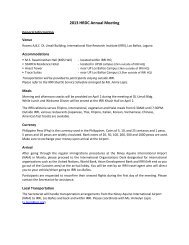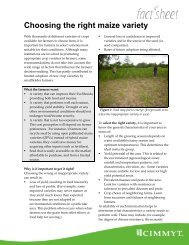Water management in irrigated rice - Rice Knowledge Bank ...
Water management in irrigated rice - Rice Knowledge Bank ...
Water management in irrigated rice - Rice Knowledge Bank ...
- No tags were found...
You also want an ePaper? Increase the reach of your titles
YUMPU automatically turns print PDFs into web optimized ePapers that Google loves.
Flooded yield (t ha –1 )87A65432102001 2002 2003 2004 2005% Aerobic yield1009080706050403020100Cont<strong>in</strong>uousNewRestored2001 2002 2003 2004 2005YearFig. 3.9. Yield of aerobic <strong>rice</strong> variety Apo under floodedconditions (A) and relative yield of Apo under aerobicconditions (as % of the Apo yield under flooded conditions)(B). In B, the black columns <strong>in</strong>dicate cont<strong>in</strong>uous aerobicconditions, the darkly shaded column <strong>in</strong>dicates yield undernew aerobic conditions after conversion of flooded fields,and the lightly shaded column <strong>in</strong>dicates yield under restoredaerobic conditions after 1 year of fallow or flooded conditions(average is given). Data from Bouman et al (2006a).flooded <strong>rice</strong>-<strong>rice</strong> cropp<strong>in</strong>g (Roland Buresh, personalcommunication).There are <strong>in</strong>dications that soil-borne pestsand diseases such as nematodes, root aphids, andfungi occur more <strong>in</strong> nonflooded <strong>rice</strong> systems than<strong>in</strong> flooded <strong>rice</strong> systems (Sharma et al 2002, S<strong>in</strong>ghet al 2002, Ventura and Watanabe 1978, Venturaet al 1981). Current experience is that under fullyaerobic soil conditions, <strong>rice</strong> cannot be grown cont<strong>in</strong>uouslyon the same piece of land each year (ascan be successfully done with flooded <strong>rice</strong>) withouta yield decl<strong>in</strong>e (George et al 2002). Figure 3.9presents recent data from a cont<strong>in</strong>uous aerobic <strong>rice</strong>cropp<strong>in</strong>g experiment at IRRI (Bouman et al 2005,Peng et al 2006). S<strong>in</strong>ce 2001, aerobic <strong>rice</strong> varietyApo has been cont<strong>in</strong>uously grown under floodedand aerobic conditions <strong>in</strong> the same field. Floodedyields <strong>in</strong> the dry season are usually 6.5−7 t ha −1 ,except <strong>in</strong> 2001, when diseases depressed yields. InBYield (kg ha –1 )2,5002,0001,5001,0005000060120N (t ha –1 )160200Fig. 3.10. Yield of aerobic <strong>rice</strong> variety Apo under aerobic soilconditions at IRRI <strong>in</strong> 2004, at four levels of fertilizer N supply,and under three levels of water <strong>in</strong>put (black column = 1,147mm, darkly shaded column = 772 mm, and lightly shadedcolumn = 632 mm). Unpublished data, IRRI.2001, yield under aerobic conditions was 86% ofthat under flooded conditions, but this graduallydecl<strong>in</strong>ed until it was only 45% <strong>in</strong> 2005. In 2003,half of the flooded fields were converted to aerobicconditions, and aerobic yields returned to 85% ofthe flooded yields, as <strong>in</strong> the first year, 2001. In 2004,half of the cont<strong>in</strong>uous aerobic fields were left fallowor were flooded for the whole year, and returnedto aerobic conditions <strong>in</strong> 2005. This “restoration”attempt brought aerobic yields back to 65% offlooded yields, and was only partially successful.The mechanisms beh<strong>in</strong>d the gradual yield decl<strong>in</strong>eand the restoration effect are not yet understood,although high levels of the nematode Melodoigynegram<strong>in</strong>icola are found <strong>in</strong> the aerobic <strong>rice</strong> fields(up to 3,000 counts g −1 fresh root) compared withthe flooded fields (6−400 counts g −1 fresh root;unpublished data).In some field experiments and farmers’ fields,nearly complete yield failure has been observed <strong>in</strong>fields where aerobic <strong>rice</strong> was established the veryfirst year (Fig. 3.10). Usually, such fields had a lightsoil texture and a history of be<strong>in</strong>g partially croppedto upland crops or to <strong>rice</strong> under nonflooded conditionsbefore aerobic <strong>rice</strong> got established. Always,nematodes were found when yield failures wereobserved, sometimes aggravated by the presence ofroot aphids, fungi, and/or nutrient disorders. Croprotation is necessary under such conditions, andbreeders are try<strong>in</strong>g to develop aerobic <strong>rice</strong> varietieswith tolerance of these soil sicknesses.33





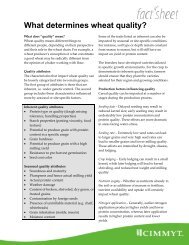

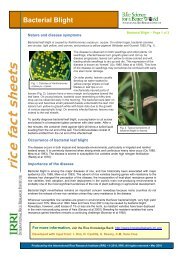

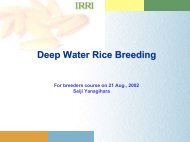
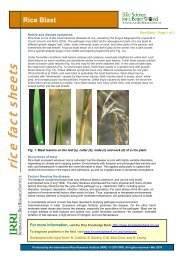
![International Standards' Organization â Rice Specification [ISO 7301]](https://img.yumpu.com/36696862/1/190x245/international-standards-organization-a-rice-specification-iso-7301.jpg?quality=85)

